
(a)
Interpretation:
By using
Concept introduction:
For the analysis of the molecular formula of organic molecules, the sites of unsaturation, also known as IHD is used for the determination of the total number of ring and
In condensation reaction, the loss of water takes place.
Absence of
Absence of
Absence of
Answer to Problem 18.98P
Structure of the
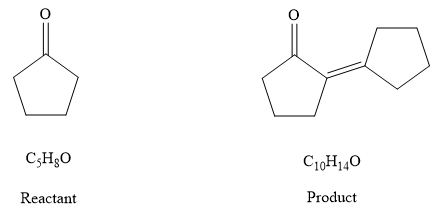
Explanation of Solution
IHD of
Comparing the formulas
The compound

From the proton NMR, there is no alkene proton signal at
The NMR signal for the product is clear; there are five chemically distinct groups of protons. All the NMR signals in the product are
So, the structure of product is
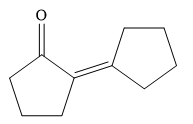
So, the reactant ketone with formula

So, the structure of the

By using the given
(b)
Interpretation:
Mechanism of the given Aldol condensation reaction is to be determined.
Concept introduction:
In Aldol reaction,
In Aldol reaction, dimerization of an aldehyde or ketone to
For this reaction, the presence of
In the heterolysis step, water is removed and alkene (
Answer to Problem 18.98P
Mechanism of the given reaction is
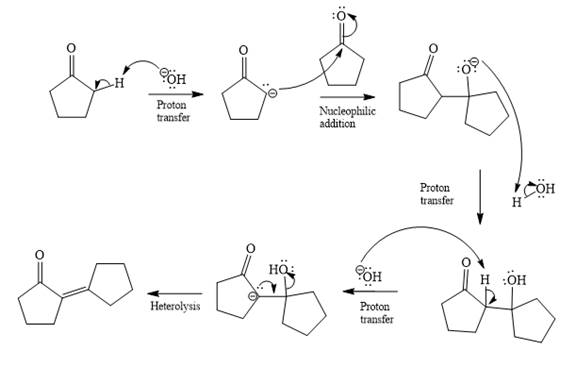
Explanation of Solution
In the first step, the most acidic proton at alpha position in cyclopentanone is abstracted by the base. Hydroxide ion

In the second step, nucleophilic addition takes place; the enolate anion acts as a nucleophile, and it will attack the second molecule of cyclopentanone. In this step, a new
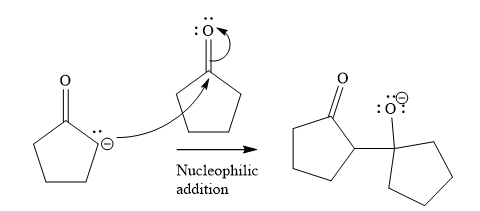
The third step is proton transfer.

In fourth step

Last step of the reaction is heterolysis in which water is removed and

Complete and detailed mechanism for the given reaction is
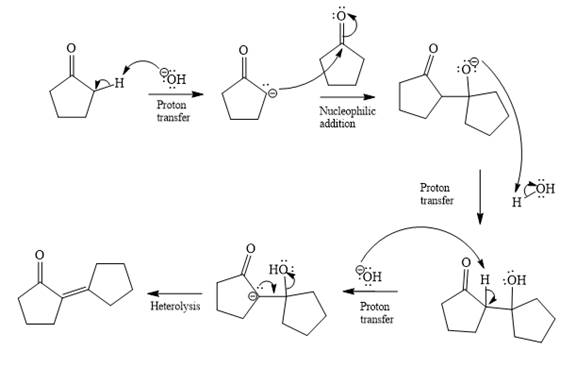
By using Aldol condensation reaction, the mechanism of the given reaction is determined.
Want to see more full solutions like this?
Chapter 18 Solutions
ORGANIC CHEMISTRY E-BOOK W/SMARTWORK5
 ChemistryChemistryISBN:9781305957404Author:Steven S. Zumdahl, Susan A. Zumdahl, Donald J. DeCostePublisher:Cengage Learning
ChemistryChemistryISBN:9781305957404Author:Steven S. Zumdahl, Susan A. Zumdahl, Donald J. DeCostePublisher:Cengage Learning ChemistryChemistryISBN:9781259911156Author:Raymond Chang Dr., Jason Overby ProfessorPublisher:McGraw-Hill Education
ChemistryChemistryISBN:9781259911156Author:Raymond Chang Dr., Jason Overby ProfessorPublisher:McGraw-Hill Education Principles of Instrumental AnalysisChemistryISBN:9781305577213Author:Douglas A. Skoog, F. James Holler, Stanley R. CrouchPublisher:Cengage Learning
Principles of Instrumental AnalysisChemistryISBN:9781305577213Author:Douglas A. Skoog, F. James Holler, Stanley R. CrouchPublisher:Cengage Learning Organic ChemistryChemistryISBN:9780078021558Author:Janice Gorzynski Smith Dr.Publisher:McGraw-Hill Education
Organic ChemistryChemistryISBN:9780078021558Author:Janice Gorzynski Smith Dr.Publisher:McGraw-Hill Education Chemistry: Principles and ReactionsChemistryISBN:9781305079373Author:William L. Masterton, Cecile N. HurleyPublisher:Cengage Learning
Chemistry: Principles and ReactionsChemistryISBN:9781305079373Author:William L. Masterton, Cecile N. HurleyPublisher:Cengage Learning Elementary Principles of Chemical Processes, Bind...ChemistryISBN:9781118431221Author:Richard M. Felder, Ronald W. Rousseau, Lisa G. BullardPublisher:WILEY
Elementary Principles of Chemical Processes, Bind...ChemistryISBN:9781118431221Author:Richard M. Felder, Ronald W. Rousseau, Lisa G. BullardPublisher:WILEY





